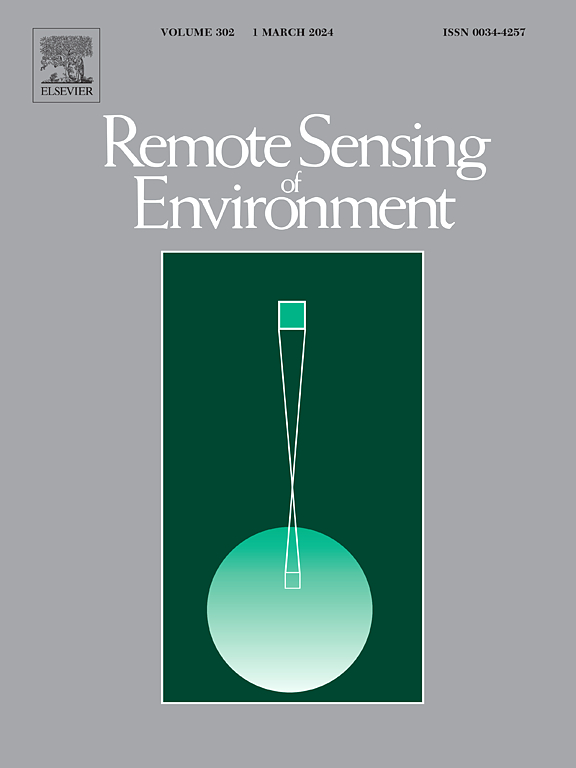An integrating pre-temperature description method for generating all-weather land surface temperature via passive microwave and thermal infrared remote sensing
IF 11.1
1区 地球科学
Q1 ENVIRONMENTAL SCIENCES
引用次数: 0
Abstract
Integrating passive microwave (PMW) and thermal infrared (TIR) remote sensing to generate all-weather land surface temperature (LST) is essential for effective land thermal monitoring. Previous studies have attempted to adapt TIR-interactive kernel-driven downscaling techniques into the PMW-TIR integration process. However, large-scale spans often introduce significant uncertainties in the generated LST, potentially leading to spatial streaks. To address these challenges, it is critical to introduce a reliable temperature representation at the target resolution to generate accurate all-weather LST. In this study, we propose an integrated pre-temperature description model (ITDM) comprising three modules. The first module is a machine learning-based bias correction-driven generation module (BCDM), which generates relatively precise LST, particularly during the daytime, though it may smooth some spatial textures in certain regions. The second module, a spatial detail-aware generation module (SDAM), utilizes an annual temperature cycle model-based LST as a temperature description, ensuring spatial consistency in the generated LST. The third module integrates the two previous modules, addressing their differences to optimize the final output. Validation results based on MODIS LST indicate that the proposed method achieves a daytime root mean squared error (RMSE) of 3.20 K and a standard deviation of bias (STD) of 3.08 K. For nighttime, the RMSE and STD are 2.24 K and 2.15 K, respectively. Additionally, ten in-situ measurements reveal an average RMSE of 3.90 K in the daytime and 3.34 K in the nighttime. Comparative results with two other advanced methods based on MODIS LST and in-situ LST show that the proposed approach reduces RMSE by 0.04–0.91 K and mitigates streaking phenomena more effectively. The study also discusses feature importance, module performance, and the extendibility of the method. The proposed model significantly contributes to the generation of high-quality all-weather LST.
被动微波与热红外遥感全天候地表温度综合预温描述方法
将无源微波(PMW)和热红外(TIR)遥感相结合,生成全天候地表温度(LST),是实现有效的地表热监测的关键。以前的研究试图将tir交互核驱动的降尺度技术应用到PMW-TIR集成过程中。然而,大尺度跨度往往在生成的地表温度中引入显著的不确定性,可能导致空间条纹。为了应对这些挑战,在目标分辨率下引入可靠的温度表示以生成准确的全天候LST至关重要。在本研究中,我们提出了一个包含三个模块的集成预温描述模型(ITDM)。第一个模块是基于机器学习的偏差校正驱动生成模块(BCDM),它生成相对精确的LST,特别是在白天,尽管它可能会平滑某些区域的一些空间纹理。第二个模块是空间细节感知生成模块(SDAM),它利用基于年温度周期模型的LST作为温度描述,确保生成的LST的空间一致性。第三个模块集成了前两个模块,解决了它们之间的差异,以优化最终输出。基于MODIS LST的验证结果表明,该方法的日间均方根误差(RMSE)为3.20 K,偏差标准偏差(STD)为3.08 K。夜间,RMSE和STD分别为2.24 K和2.15 K。此外,10次原位测量结果显示,白天和夜间的平均RMSE分别为3.90 K和3.34 K。与基于MODIS LST和原位LST的其他两种先进方法的对比结果表明,该方法可将RMSE降低0.04 ~ 0.91 K,并能更有效地缓解条纹现象。研究还讨论了该方法的特征重要性、模块性能和可扩展性。该模式对高质量全天候地表温度的生成有重要贡献。
本文章由计算机程序翻译,如有差异,请以英文原文为准。
求助全文
约1分钟内获得全文
求助全文
来源期刊

Remote Sensing of Environment
环境科学-成像科学与照相技术
CiteScore
25.10
自引率
8.90%
发文量
455
审稿时长
53 days
期刊介绍:
Remote Sensing of Environment (RSE) serves the Earth observation community by disseminating results on the theory, science, applications, and technology that contribute to advancing the field of remote sensing. With a thoroughly interdisciplinary approach, RSE encompasses terrestrial, oceanic, and atmospheric sensing.
The journal emphasizes biophysical and quantitative approaches to remote sensing at local to global scales, covering a diverse range of applications and techniques.
RSE serves as a vital platform for the exchange of knowledge and advancements in the dynamic field of remote sensing.
 求助内容:
求助内容: 应助结果提醒方式:
应助结果提醒方式:


